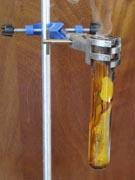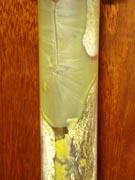A demonstration with some fantastic chemistry
This demonstration involves some fantastic chemistry and makes an excellent introduction to the use of quantitative calculations to find the formula of a reaction product, copper sulfide. Students will also get the chance to see some of the allotropes of sulfur.
Making copper sulfide
Copper wire reacts readily with hot sulfur gas to form copper sulfide:
Cu(s) + S(g) → CuS(s)

Kit
- Boiling tube containing a 2cm depth of sulfur;
- Small glass hook, 2mm diameter;
- Copper wire, 8 cm length and 1.25mm diameter;
- Fume cupboard, Bunsen burner, retort stand, boss and clamp (steel/iron), heat-proof mat and tongs;
- Accurate balance (1/100g minimum).
Procedure
Fill a boiling tube with a 2 cm depth of sulfur. Cut an 8 cm long piece of copper wire, weigh it and record the mass. Gently heat a 2 mm diameter glass rod and shape it into a small glass hook that will hang over the lip of the boiling tube. Hang the piece of copper wire over the hook, inside the tube. Clamp the tube at its top in position above a Bunsen burner on a heat-proof mat in a fume cupboard and ensure the copper wire hangs freely without touching the sides of the glass tube.
Place a roaring Bunsen burner below the tube and leave for five minutes. Often the sulfur gas will ignite and burn with a beautiful blue colour, this is not a problem. Also, you may find the lining of the jaws of the clamp will burn, but again this is not a problem when performed in a fume cupboard.

On heating, the first observation will be the sulfur melting into a yellow, mobile liquid as it changes into monoclinic sulfur (S8 rings). As the temperature rises further the liquid darkens until it is nearly black and, unusually, it becomes more viscous owing to the formation of long, tangled chains of sulfur. Further heating past 200°C and the viscosity falls as the long chains breakdown to form shorter ones until the liquid starts to boil at 445°C at which point sulfur vapour can be seen subliming to form a pale yellow solid on the cooler, upper walls of the boiling tube. The copper wire reacts readily with the hot sulfur gas (S8, S4 and S2), forming a dark grey, brittle crystalline solid of copper sulfide.
After ca five minutes of heating, carefully remove the hook and copper sulfide using tongs and allow any excess sulfur to burn, thus cleaning the copper sulfide. Allow to cool and re-weigh the copper sulfide noting the mass. After weighing, it is well worth breaking the copper sulfide so that your students can examine the crystalline structure within.
As the sulfur in the boiling tube cools I highlight to my students how the viscosity of the liquid changes on the tube wall. When the tube is almost cool enough to touch the sulfur changes from a sticky, treacle-like fluid to a more honey-like liquid. At this point scratch the inside of the glass tube with the end of a pair of sharp scissors so that your students can watch the sulfur crystallise, much like frost forming on a window. Note the increase in temperature as new bonds are formed.
Safety
Sulfur dioxide is toxic by inhalation and irritating to the respiratory system so this demonstration must be performed in an efficient ducted or re-circulatory (filter) fume cupboard. Copper sulfide is an irritant so students should wear gloves when they handle it.
Teaching goals
For Year 10 students this demonstration can help to relate the mole to a real-life problem, ie finding the formula of a compound. Table 1 shows the data and calculations required to find the formula of copper sulfide (0.882g) produced by the reaction of copper wire (0.560g) with sulfur gas. The next lesson can then be a class practical to find the formula of magnesium oxide by burning a piece of magnesium ribbon in a crucible with a lid - though the results are not so good for this experiment.
This demonstration can also be used when revisiting the mole in Year 12, with particular emphasis on the correct use of units and significant figures in the calculations.
| Element | Copper | Sulfur |
| Mass in copper sulfide/ g | 0.560 | 0.262 |
| Realtive atomic mass/ g mol-1 | 63.5 | 32.1 |
| Amount/ 10-3 mol | 0.560 g/63.5 g mol-1 = 8.81 | 0.262 g/32.1 g mol-1 = 8.16 |
| Ratio (approx) | 1 | 1 |









No comments yet